Word durbar comes from the Persian language and means nearly the same as 'the court of Shah'. In Nepal, with this word it is also called the main square of the city, on which the king's palace is located. Before the reunification of the country in the middle of the eighteenth century there were three kingdoms, therefore, in the valley of Kathmandu we can find three so-called durbar squares: one in Patani, one in Bhaktapur and one is located in Kathmandu. Nota bene, all three buildings have been inscribed on the UNESCO World Heritage List.
The most important building on the Durbar Square1 is obviously the palace. The one in Kathmandu – Hanuman Dhoka Durbar (Royal Palace of Hanuman) – took its name from statue of Hanuman – the monkey god, which was built in 1672 by King Pratap Malla to guard the palace gates.
Most of the Katmandu’s monuments are situated at the Durbar Square. Not only we can visit the already mentioned palace, but also we can admire the towering pagodas, majestic statues and the residence of living goddess Kumari – it is one of the numerous testimonies of newar artisans craftsmanship – and many other places of worship for both Hindus and Buddhists that were developed over the centuries. You can also watch a fascinating and colorful life of Nepalese. Enjoy.
ATTENTION! Everyone who visited Nepal or is planning to go there soon is kindly invited to contribute to this guide. Any inquires regarding this matter should be referred to the editor's address redakcja@libertas.pl.
The tourists can get at the Durbar Square in a number of ways. The most common one is, of course, by paying the appropriate fee in one of the cash registers guarding the square. One-day entrance fee costs 300 rupees. If we want to visits the historic district of Kathmandu more often, it is a good idea to issue a legitimacy on the basis of the ticket, which allows the tourists to move around the Durbar Square as long as their visa is valid. For such a permit – the so-called Visitor Pass – you do not have to pay any extra money. Just go to the office, which is located near the Kumari Palace, you show your ticket, passport, fill in the appropriate document and attach to it one legitimacy photo.
If the expenditure of 300 rupees is a big problem, you can always try to get to the Durbar Square for free. There is Freak Street – it was known in the 70. as the street of „flower children” which leads to the square from the south and more importantly, there are no cash registers. Yet, you need to stay away from the guards while you will be visiting Durbar Square to avoid possible inspection of tickets.
The last way to get to the Durbar Square is a nod to the local tax-free enterprise and rent one of the guides, who waits for a large group of tourists in front of cash registers. For the services of each of the guides you pay a few hundred rupees. It is worth to bargain.
If during your stay at the Durbar Square, you would also like to explore the Hanuman Dhoka – a former seat of the king, which currently is a museum – you have to reckon with an additional fee of 250 rupees per person. Please note that during major holidays (Dashain, Tihar), the palace is closed to tourists.
1. Maju Deval Shiva, 2. Kam Dev Temple, 3. Shiva and Parvati Temple, 4. Narayan Temple, 5. Lakshmi and Narayan Temple, 6. Ashok Binayak, 7. Temple of Shiva (Mahadev Bisweshwar) 8. Kasthamandap, 9. Gaa Kuti Mahadev, 10. Bhairava Temple, 11. Kabindrapur Temple, 12. Bimaleshwor Temple, 13. Trailokya Mohan, 14. Garuda Statue, 15. The palace of living goddess Kumari (Kumari Bahal), 16. The Great Bell (Tago Gän), 17. Vishnu Teple 18. Temple of Saraswati (Saraswati Mandir), 19. Krishna Mandir, 20. The Great Drums, 21. Kotilingeshwar Mahadev, 22. Nil Barahi Temple, 23. Temple of the Great Vishnu (Maha Vishnu Mandir) 24. Shiva Temple, 25. Mandir Mahendreshwar, 26. Tarana Devi Mandir, 27. Royal Temple of Goddess Bhawani Taleju (Taleju Temple), 28. Kakeshwar Temple, 29. The stone inscription of King Pratap Malla, 30. Gopinath Mandir 31. Indrapura Temple, 32. The Black Bhairava (Kala Bhairav), 33. King Pratap Malla's Column, 34. Mask of the White Bhajrava (Seto Bhairav), 35. Jagannath Mandir, 36. Hanuman Statue, 37. Coronation courtyard (Nasal Chowk), 38. Tribhuvan Museum, 39. Basantapur Tower (Basantapur Durbar), 40. Pancha Mukhi Hanuman Temple, 41. Degutalle Temple, 42. Bhagwati Mandir, 43. Gaddi Baithak Durbar

Built in 1690 by the mother of King Bhaktapuru – Bhupatindra Malla – Maju Deval is one of the most impressive temples in Durbar. It is quite likely that it will be the first temple you are going to see, because it is located at the north-western entrance to the square, leading from the Chhetrapati Chowk. Pagoda stands on a nine-step brick plinth which makes it difficult to overlook. It has a wooden door-case, windows, pillars and beautifully carved supports, against which the triple roof leans. It is said that in the temple there are effigies of Hindu deities, as well as lingam2, but probably they are not available to the visitors. Due to the height it is a great place to look at the surrounding buildings of almost a bird's eye. Maju Dewal is often referred to as the Hippie Temple. This name is not accidental. In the 70s of the twentieth century, the temple was one of the favorite feasting destinations for "flower children" coming to Nepal from Europe and the United States.

In front of the main stairs to Maju Dewal, on the left, there is a small Sikhar – a needle-shaped tower symbolizing the peak of the mountain. We do not know much about this temple, we are not even sure about the accuracy of its name, because the sources are uncertain. Maybe it is dedicated to Kamadeva – the god of love and desire. Kamadeva, like our Cupid, is armed with a bow, but his bow is made of sugar cane, a chord is made of bees, and the shots are decorated with flowers. One story says that once, when Shiva was absorbed in meditation, Kamadeva fired his arrow at him to get him to beget a child with Parvati. After the shot, Shiva opened his third eye and burned Kamadeva. But the world could not exist without the love and desire, so the Great God brought Kamadeva back to life.
Shiva Parvati Temple was built in 1790, when on the throne in Kathmandu sat king Rana Bahadur Shah. The temple perches on a brick, three-step platform. The entrance of the temple is guarded by the two manasys – a creatures which are combination of a lion and a dragon, which are characteristic for Nepal – and from the central, richly ornated window located at the upper balcony two wooden figures of Shiva and his powerful beningnant wife Parvati look at the life at the Durbar Square. The divine couple, as usual, is shown in a passionate, mutual embrace, which is suppose to emphasize an unusual enhance sensuality and physicality of their sacred union.
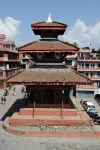
Narayan Temple is a classic Nepalese pagoda located directly in the neighbourhood of Shiva Parvati Temple, devoted to Narayan. Narayan is one of the Hindu gods. In the old stories, Narayan was described as a god of water, Husband (Purusha) – the personification of the universe, sometimes Narayan is equated with Brahma. With the development and evolution of the subsequent trends in Hinduism, Narayan’s form gradually approached to Vishnu to finally almost completely merge with this "guardian of the world", especially with his eighth avatar (incarnation) – Krishna.
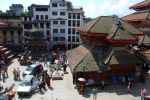
Lakshmi, for whose honour Lakshmi Narayana Temple was once errected, is a very important and popular figure in the world of Asian religion. She is a goddess of abundance and prosperity, good and fruitful mother and a faithful wife of Vishnu. Although in Nepal Lakshmi is worshiped by almost everyone, regardless of social status and religion – Hindus, Buddhists, Jains – temples devoted to her are rather rare. The praise of name of Lakshmi by Nepalese is best seen during the October festival called Tihar.

Located in the southern part of Durbar Square, an inconspicuous Ashok Binayak is one of the four most important temples dedicated to Ganesha in the Kathmandu valley. It's a very popular place which is visited in crowds by both Hindus and by the Buddhists. It is said that the pilgrims often first come to pray to Ganesha, and after that they visit other holy places of the Durbar Square. It is not known exactly when the church was built, but the gilded roof was added in the nineteenth century. A characteristic feature of this temple is that it does not have a finial. The name Ashoka Binajak comes from the Ashoka tree that has supposedly once shrouded temple. Gold replica of Ashoka – a Hindu symbol of love – is above the image of Ganesha. Unfortunately, when we visited Kathmandu the renovation of the temple lased therefore, in the pictures mainly corrugated sheet and flowers can be seen.
Kasthamandap, also known as Maru Sthal, is one of the oldest buildings of the capital of Nepal and what is even more interesting, the modern name of the city – Kathmandu – comes from the name of the building. In Sanskrit kastha (काष्ठ) means wood and a mandap (मंडप / मण्डप) is a roofed shelter, which perfectly describes this pagoda, built in the twelfth century3, which originally served as a meeting hall and was built of wood without the use of nails. It should be added here that, according to the legend, this large, three-floor building was to be constructed not just made of wood, but specifically from one tree! Since the pagoda was completely rebuilt in the late sixteenth and seventeenth centuries, it can be concluded that either the first building was much smaller, or in the twelfth century in the Kathmandu valley grew giant trees...
Today the temple is the houses of the shrine of Guru Gorakhnath, the Hindu saint who lived in the eighth century, whose little statue is in the middle of the temple, behind a wooden balustrade. The ground floor of the temple is open. In each of the four corners there is one Ganesha.
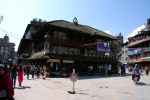
Bhairava Temple is a large house located in the south of Kasthamandap, which according to the legend was to be built of wood that was left after the construction of the latter one. The three-condignation building houses a small temple of Lord Krishna, where once reportedly people gathered to sing religious songs called bhajan. The last renovation of the building took place after the earthquake in 1934.

Kabindrapur is a temple built by Pratap Malla in 1673. Ii is dedicated to Shiva in its most popular form – as Nataraja – god of dance. This multi-condignation building serves as a temple, but also as a place for many the seventeenth-century Hindu sculptures. As like the previous one, it was renewed in 1934.


Trailokya Mohan was probably built in 1690 (although sources also mention the year 1670 and 1680). This high, standing on the five-level pedestal pagoda, is next after the Maju Dewal favorite place visited by the tourists, and on the steps of it and around the temple is located a flourishing trade in fruit and vegetables. The temple is dedicated to Lord Vishnu Narayanaa, and in front of the entrance on the west side the mount of Lord Vishnu Narayanaa kneels – the divine bird Garuda. The temple is associated with the September festival Indra Jatra, during which the crowds of people come here to see the dance showing the ten incarnations of Lord Vishnu (Dashavatara).
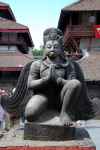
Stone Garuda Statue stands on a pedestal near the Mohan Trailokya that faces to the west entrance. It is the most likely that like the temple, the statue was built in the late seventeenth century. Garuda is yet derived from the Vedas tradition the solar deity. According to ancient Indian myths, the son of the patriarch Kashyapa and his wife Winata, a powerful bird-sun, the legendary rival of Indra, a fierce enemy of snakes symbolizing the powers of darkness and land. In Hinduism, Garuda was announced as the mount of Vishnu. Most often Garuda is portrayed as a figure of the human body with feathered wings, sometimes with bird head and curved beak.
Palace Kumari (Kumari Bahal) is a three-storey, richly decorated building planned in the quadrangle with a courtyard in the middle of it. The temple was built in 1757 by King Jaya Prakash Malla and is also the home of Kumari, the living goddess who is believed to be an incarnation of the goddess Devanagari (तलेजु) – an Indian counterpart for the warrior goddess Durga. You can sometimes see the goddess herself, in a beautiful, wooden windows on the third floor, being accompanied by her priestesses, who are taking care of the goddess. The goddess leaves her temple only during Indradźarta. Then she rides with an uniquelly decorated chariot pulled by the faithful believers to donate and put to the king (now to the president) a tika sign – a sign of luck on his forehead.
Kumari is chosen among 4–5 year-old daughters from a newar goldsmiths’ clan from which came the Buddha. It is a complex process in which the priests, led by the high priest of the temple and the royal astrologer of Taledźu temple, find the right girl. The candidate must be healthy, her body can not have any defects, and in addition, she must meet 32 very specific requirements. For example, a girl has to have black hair, eyelashes like a cow, the body like banyan fig tree, thighs like a deer, a lion's chest, neck like a sea shell, a small tongue, soft voice like a duck, and so on. Ten selected candidates must also demonstrate their courage. During the dark night, 108 buffaloes and goats are sacrificed to goddess Kali, and their severed heads are put around the courtyard of the Teladźu Temple. The girls have to go past them impassively, showing no fear, while the masked, scary-looking men, are dancing among them. Those who pass the test are closed with those cut heads for the night. During the final exam, the future Kumari must recognize things which belonged to her predecessor, which she had never seen before. This is the ultimate proof that in this particular girl a goddess is present. Goddess must be evergreen and can not bleed, so as soon the girl gets her first menstruation (or in ither way she loses even a drop of her blood) a goddess transferrs to another body.

The Great Bell (Tago Gän), is one of the three great bells in the Kathmandu valley, which was founded by King Rana Bahadur Shah and his queen Rajeswori Raj in 1797. The bell is based on two pillars and the roof is covered with piles. It is used just in honor of the goddess Taledźu, and its sound is strippes off evil spirits.
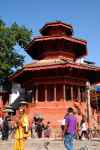
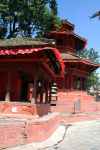
In 1649 Pratap Malla founded Krishna Mandir, which was dedicated to the memory of two dead queens (Satyabhama and Rukmani). Apparently, in the inside there is Krishna and two goddesses, and an inscription in Sanskrit says that they have been given the appearance of the king and his two wives. Unfortunately, we weren’t in the middle, so we can not verifythis fact.
Another name for this mandir is Vansagopal, which means "Lord Krishna playing the flute." The temple was built on an octagonal and is one of the most beautiful temples in the Durbar Square, perhaps also because it has been relatively recently, in 1967, renewed.
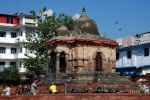
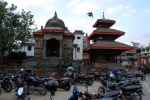
Mahadev Kotilingeshwar is a stone temple which was founded in the sixteenth century during the reign of King Mahendra Malla. It was built in the style of gumbhaj, which means it is rectangular in shape and covered with a bell-shaped dome. Next to the temple, the bull Nandina is sitting – it is a mount (vahana) of the god Shiva, from which you know that the temple is dedicated to just this powerful "three-eye god".

The Temple of the Great Vishnu (Maha Vishnu Mandir) stands on the four-level foundation and it is covered by a two-level roof. Apparently, during the earthquake in 1934, the temple was badly damaged and till today Nepalese failed to finish fixing it, even though it is hard to find any visible defects from the outside.
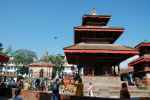
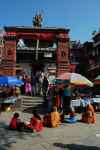
Mandir Mahendreshwar is dedicated to Shiva and is one of the most famous temples in the valley. It is located on the northern end of Durbar Square and was founded in 1561 or 1562, during the reign of King Mahendra Malla. Inside the temple there is a lingam – associated with Shiva a symbol of the highest principles. There is also a bull Nandin – a mount of Shiva. The gate of the temple must have been created recently.
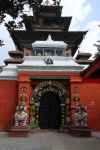

Devoted to the royal family the Temple of Taledźu Bhawani Goddess (Taleju Temple) is the highest temple in Kathmandu. Mandir is 36.6 meters high and rests on a twelve-step pedestal and three-level roof of the temple dominates over the royal palace. The temple was built in the year 1564 (or 1562), by King Mahendra Malla, who then issued a decree, that in Katmandu there can not arise any building taller than the temple, which did not happen until the mid-twentieth century.
The Temple of Taleju Goddess is considered so sacred that once only the king and the chief priests had the access to it. Today it is opened only once a year, during Durga Puja – the ninth day of Dashain – and even then only Hindu people may only exceed the thresholds.
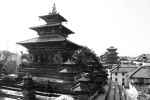
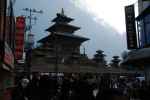
Taledźu Bhawani, the incarnation of goddess Durga, in the fourteenth century was considered aa a deity of the royal family. Apparently sometime human sacrifices were conducted in the temple, but the goddess was not happy with that, and abandoned these practices, and since the late eighteenth century, a human sacrifice is prohibited even the law!

The Temple of Mahadev Kakeshwar (Kakeshwar Temple) was built in 1681 and rebuilt after it was severely hit by an earthquake in 1934. What is interesting is the fact that the base of the temple is a typical Nepali one and the culmination of the temple is a more popular form in India shikhara.
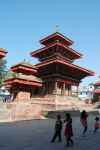
Gopinath Mandir is dedicated to Krishna – The Lord of the Shepherd (Gopi – young shepherdess of cows absolutely committed to Krishna, secretly escaping at night to dance with Krishna on the bank of the Yamuna). The temple has a three-level roof and stands on a three-level plinth.

Right next to the door of Gopinatha Mandir stands the Indrapur Temple. Some sources claim that it is very old, but the renovation has erased the traces of its history and we know nothing about it. It is even problematic to determine to whom the temple is dedicated, because lingam in the middle of the temple suggests that it is dedicated to Shiva, the presentation of Garuda suggests Vishnu and the name of the temple contradicts everything, because it says that the temple is dedicated to Indra.
Indra is the most important god of the Vedic pantheon, he is the master of rain and storm, the god of war, the personification of the militant nature of the Aryans. In Hinduism as a result of the emergence of the Trinity – Trimurti: Brahma, Vishnu and Shiva, Indra lost its importance remaining only one of the guardians of the world, the East direction guardian.
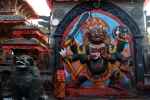
The Black Bhairava (Kala Bhairav) is one of the most terrifying incarnation of Lord Shiva. The eight-arm god wields six swords, an ax and a shield, he has a rope of human skulls around his neck and with his leg he tramples a demon’s corpse. Apparently, everyone who lies in his presence, shall immediately die, and thus Nepalese often make a promise in front of his menacing presence that they are telling the truth. A bas-relief set at the Durbar Square has only six hands, but it makes a lasting impression. It is not known exactly when it was established, but it is known that in that place where the statue now stands, it was set by King Pratap Malla after it was found it in the fields in the north of Kathmandu.

King Pratap Malla's Column – he was a king who lived in the years between 1624–1674, and for whose reign most of the buildings on Durbar was built. His reign is considered to be economic and cultural peak of the Mallas dynasty. A sitting king surrounded by his two wives and four sons. He is faced towards the windows of a private temple of Degu Taleju, in which he prayed during his lifetime.

Mask of the White Bhajrava (Seto Bhairav) – a terrifying incarnation of Shiva – was established in 1794 during the reign of Rana Bahadur Shah. It is three meters high and it is hidden behind an openwork, wooden door. It can be seen only a few days in a year, in September, during the feast of Indra Jatra, when it is unmasked and decorated with flowers and rice, and at the time from the mouth of Bhajrava floats beer.
Jagannath Mandir is located right at the entrance to the Palace of Hanuman and it is a two-storey, one of the oldest temples in Durbar, which was built in 1563. It is dedicated to Krishna – the Lord of the World (jjagatj – "world", jnāthj – "lord") and it is known among other things for the beautifully carved roof supports of erotic scenes.
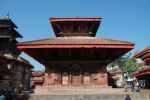
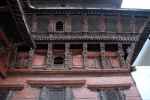
Hanuman Dhoka Durbar is a palace complex, which was probably built during the Lichchhavi Dynasty or earlier, but today's appearance is primarily due to the king Pratap Malla and his dynasty, when the greater part of the palace buildings was built.
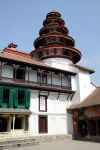
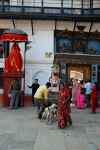
Before entering the palace, on the platform, there is a Hanuman Statue – he is a Hindu monkey god who is always portrayed as a figure sitting on a high stone pedestal. The statue was consecrated by Pratap Malla in 1672. On the right there is the Golden Gate, the main entrance to the Royal Palace of Hanuman (Hanuman Dhoka Durbar), guarded by a pair of stone lions.

By entering the golden gate you will get to the main courtyard of the palace – Nasal Chowk – on which important ceremonies, such as coronations, are held. When we visited the palace immediately after Tihar, on the middle of the courtyard there were still traces of the recent pilled up large mandala. On the right there is the entrance to the museum.
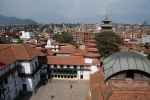
In the museum you can see, among others, a stuffed and firmly dusty king’s canary and hundreds of photos and other memorabilia of the monarchy. Frankly speaking, this massive and rather monotonous boring exposition can probably bore even the biggest enthusiast of Nepal. But in the end you do not need to visit the whole exposition.
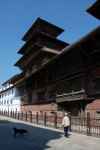
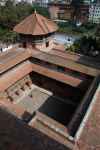

From the side of the courtyard or through the museum you can enter the nine-stock high, the palace tower of Basantapur (Basantapur Durbar), a thumping among other buildings, which offers a view of the Kathmandu and palace buildings. King Prithvi Narayana Shah built it in 1770 after he conquered and united the Kathmandu valley. Basantapur Tower, also known as the Tower of Kathmandu, is one of the four towers surrounding Lohan Chowk. Each tower represents one of the major cities of the ancient valley and is named after each nof the cities: Kathmandu Tower, Tower Laliptur (Patan), Bhaktapur Tower and Kirtipur Tower. Apparently, each building was financed by the residents of the city, whose name bears the tower.

Unfortunately, not every part of the palace is open to the public view, so some of its parts can be admired only from the outside. After leaving, you will see again the Column of the King Pratap Malla. The King looks at the palace Degutalle Temple. Interestingly, it starts from the second floor (below there are shops), and you can enter it only through the palace.
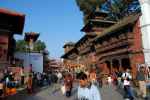
Going back towards Maju Dewal on the left side you can see Bhagwati Mandir – a three-leveled temple built by Jagat Jaya Malla. Below it, on the ground floor, there is a shop with tanks. Initially, the mandir was devoted to Narayan, but in 1766 he was being stolen from the temple. When Prithwi Shah Narayan mastered the entire valley, he placed the Goddess Bhagwati here. Every year in April, the deity is taken to the village of Nuwakot, about 65 kilometers north of Kathmandu, and after a few days she comes back to her seat.
The east side of the palace is closed with a modeled after European architecture, strikingly white, neo-classical building which seems not to quite fit with the rest on Durbar Square, which is mostly the typical Newari architecture. It was built during the reign of Rams in 1908.
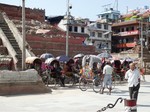
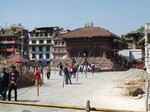
Nepal niejednokrotnie nawiedzany był przez większe lub mniejsze trzęsienia ziemi, choćby wspominany już kataklizm z 1934 roku, w wyniku którego znacznie ucierpiało wiele cennych zabytków. 25.04.2015 roku o godzinie 11:56 ziemia zatrzęsła się z siłą 7,8 stopnia w skali Richtera, potem nastąpiło 14 wstrząsów wtórnych, 8964 osób zginęło, ponad 23 tysiące osób zostało rannych, a niemal pół miliona ludzi straciło dach nad głową. Trzęsienie ziemi wywołało lawinę śnieżną na Mount Evereście, która zniszczyła jedną z baz i zabiła przebywających w niej himalaistów, a sam szczyt przemieścił się o trzy centymetry w kierunku południowo-zachodnim. Oczywiście ogromne zniszczenia dotknęły też stolicę, a wiele zabytków zostało praktycznie zrównanych z ziemią. Obok kilka zdjęć z Placu Królewskiego, zrobionych w kwietniu 2018 roku, czyli 3 lata po katastrofie.
Beautiful pagodas, temples and other monuments, which are generously scattered throughout Durbar, are certainly worth spending time with. Their uniqueness lies also in the fact that the Nepalese people apparently do not treat them as monuments. All these old, incredibly intricately decorated buildings are for them the usual temples and houses, they are places where life goes on normally. On the steps of the pagoda someone sells pomelo, and on centuries-old wooden carving the pigeons unceremoniously poot. Nothing unusual.
Durbar Square is therefore also an ideal place for voyeurs, and yet anyone who likes to travel, at some point has to have little something from a voyeur! That is why the Durbar is worth seeing, not only for its architecture, but also to see what Nepalese life looks like. As part of the rest, you can be, for example, sit down, as if in a theater box, at the highest levels of Maju Deval and long stare at the multicolored, not directed spectacle that takes place here every day. Or you can blend in with the crowd and drift into the mainstream of indeterminate direction, absorb odors, colors, exotic faces and clothes...
We like to visit the so-called poor countries. Poor because their residents do not have huge houses, do not earn thousand dollars a month, do not have expensive equipment in hospitals that do not run which ping and do not driva a Mercedes. Yes, they lack of many western features, such as automatic washing machines, and their lives are heavier and more filled with physical work, but it is also simpler, it is more human than mechanical. This life is filled with contacts with people, and not with Facebook. It is more colorful, cheaper and, hence, significantly slower than ours. Of course, sometimes you can see on the street a very expensive car, and supermarkets suggest that Western consumerism also invades the recently isolated from the world of the kingdom, but I will venture to say that life in Nepal is still slow and it is hard to notice here the busy locals.
What else can you see at the Durbar Square? The crowd in Durbar is not divided into cyclists and pedestrants. Here all flow in one mainstream, motor next to a rickshaw, a car dealer next to the bananas seller. Poverty does not allow to waste of resources, so a whole family rides on the motorbikes (we saw even after five people on one machine). Poverty is not picky, so everyone grabs something to do, no matter how ridiculous would it seem from our perspective. I mean, how much can you earn by selling fans or cotton candy? Here no work is a disgrace.
The strength and endurance of seasoned hard life of the people who carry on their shoulders the heavy weights hits the tourists. At the same time these people make balancing tricks, like the man in the picture below, who is carrying a heavy furniture and yet he has to cross the rope, crossing his path.
On the door of a small shop, which is so small, so that sales is basically run on the outside, there is a hanging goat’s head. A gutted animal lies on some old desk. This vision is in no way congruent with ours, imported from Europe, ideas of the butcher shop, without horns and hooves, not mentioning any other aspects.
Nowhere baby carriages can be seen. But after all, there are plenty of children! Just carts are not needed in a country where everything is worn on the back and on the sidewalks-streets traffic jams occur. Babies who are carried in slings do not stay away from their mothers and the older children piggyback due to the institution of the older sister. Would we leave the two-year-old child in the care of eight-year-old in the city center?
Tree’s roots burst the old chapel, someone brings the carpets, someone else comes down the ladder from the roof of the temple. Ladder certainly does not guarantee the security certificate. It was probably hastily improvised with some bamboo tree. Look at the distance between the levels! If I had not seen the man using it, I would not even comewith an idea that it is a ladder!
Although Nepal is a very popular destination for tourists not only foreign ones, but also an increasing number of Polish tourists, it still lacks a complete information about this country. In this part of the guide we tried to systematize the information about the rich in historical monuments of the Durbar Square in Kathmandu. It turned out to be a more difficult task than at first glance it might seem. It is sufficient to say that circulated in large quantities official leaflets given with the tickets to Durbar Square, which I think should be a source of information, contain errors and inaccuracies.
We are aware of the gaps in our knowledge, as well as how poor and uncertain information we have accumulated. Despite that, we figured that it is worth to take such a risk in the hope that, with the help of further hikers and enthusiasts who will visit to Nepal and the information gained there, and who will be willing to share the information, we will manage to create a comprehensive and reliable source of information about the monuments located in the Durbar Square. It seems to us that the already collected information can be a valuable aid in exploring, as well as an invitation to visit this place, so different from our world.
For any mistakes, which – we have no doubt about it – we could not avoid, I sincerely apologize, and we are grateful for pointing out and straightening them. In addition, if you are also interested in Nepal and its culture; you have some valuable information about Nepal, especially the Durbar Squre in Kathmandu, we would appreciate any help in the development of this guide.
The official leaflets handed out to tourists entering the square there is the name "Hanuman Dhoka Durbar Square", which, given the importance of these words seems to us a little bit strange, and in native literature or anywhere such determination is not met, therefore we will use popular, Nepali-English name: "Durbar Square".
Lingam / linga / Shiva-linga / yoni-linga – a symbol of the highest principles of continuous creation of the world, connect pairs of opposites in the act of creation, in which linga is a giving and yoni is receiving.
The sources give different dates of construction of the building: the twelfth century, the beginning of the sixteenth century, 1594 and 1630. Some mention the reconstruction at the turn of the sixteenth / seventeenth century, so maybe the pagoda was built in the twelfth century and then rebuilt it completely and hence these discrepancies.
Nepal – przewodnik:
Katmandu / Kathmandu / काठमाडौ / Kantipur (Nepal) – przewodnik (105 zdjęć)Durbar Square, Kathmandu (Nepal) – guidebook (106 zdjęć)Boudhanath Stupa / Bauddhanāth / बौद्धनाथ, Katmandu (Nepal) – guidebook (32 zdjęcia)Swayambhunath / Swoyambhunath / स्वयम्भूनाथ स्तुप, Katmandu (Nepal) – guidebook (52 zdjęcia)Pokhara / पोखरा (Nepal) – guidebook (69 zdjęć)Bhaktapur / भक्तपुर / Bhadgaon (Nepal) – guidebook (82 zdjęcia)Patan / पाटन / Lalitpur (Nepal) – guidebook (84 zdjęcia)Tihar / तिहार – Festival of Lights (Nepal) – guidebook (48 zdjęć)Dhunche – Thulo Bharkhu – Thulo Syabru (Nepal) – przewodnik (55 zdjęć)Thulo Syabru – Hot Springs – Bamboo – Lama Hotel (Nepal) – przewodnik (22 zdjęcia)Lama Hotel – Ghoda Tabela – Langtang (Nepal) – przewodnik (45 zdjęć)Langtang – Yamphu – Kyanjin Gompa (Nepal) – przewodnik (51 zdjęć)Kyanjin Gompa – Kyanjin Ri – Kyanjin Gompa (Nepal) – przewodnik (43 zdjęcia)Kyanjin Gompa – Langshisha Kharka – Kyanjin Gompa (Nepal) – przewodnik (41 zdjęć)Trekking in Nepal – the most important information – guidebook (15 zdjęć)Paśupatinath, Katmandu (Nepal) – przewodnik (41 zdjęć)Dakshinkali – świątynia bogini Kali (Nepal) – przewodnik (51 zdjęć)Ceremonie religijne w Indiach i Nepalu – przewodnik (18 zdjęć)Królewski Park Narodowy Chitwan (Nepal) – przewodnik (41 zdjęć)